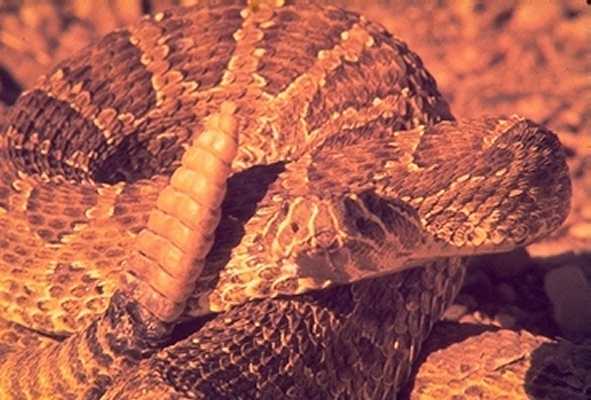Rattlesnakes
The only poisonous snakes found in southern California are seven species of rattlesnakes. There are no copperheads or water moccassins in Southern California, and for the most part no coral snakes, although there are coral snakes in Arizona. Rattlesnakes bite their victims with two fangs that are hinged to swing downward at an angle of 90° to the snake's upper jaw. The rattlesnake can open it's mouth amazingly wide, allowing venom to be injected into the victim through grooves along the fangs. The amount and toxicity of venom determine the danger to the victim. For example, venom from the Mojave Rattlesnake is approximately 44 times more potent than the venom from a Copperhead; and venom from baby rattlesnakes may be 12 times more potent than the venom from adults.
First Aid for SnakebitesNot all rattlesnake bites result in the injection of venom, in fact most don't. However, because the mouth of a rattlesnake is very unsanitary, from eating small rodents, birds and other animals, serious infection, with the ever present danger of gangrene, is very, very likely. Thus, all rattlesnake bites are very dangerous and can result in death if not tended to immediately. The injection of venom is called envenomation.
Because all rattlesnake bites are dangerous, the victim needs to seek medical help immediately. The degree of danger depends on the age, size, and health of the victim, how allergic they are to the venom, where they were bitten (near vital organs being the most dangerous), how deep the fangs go, how upset the snake is, the species and size of snake, and the first aid given. A person will normally know within the first 30 minutes, how serious a bite is. Remember that the after effects from any rattlesnake bite may last for months, even years. The First-Aid guidelines below are for bites from all poisonous snakes in the United States, including rattlesnakes, copperheads and water moccasins.
Avoiding RattlesnakesFollowing these precautions if traveling in snake country.
Southern California Rattlesnakes
The big guys Western Diamondback (Crotalus atrox) - This is the big snake of the San Joaquin Valley, and boy can it get big . . . up to 6 feet long and 4 to 5 inches in diameter. Overall, it is a brownish-colored snake, with lighter undersides. It gets it name from the distinctive diamond-shaped patches on the topside of the body. The Diamondback also has wide, light and dark tail bands, that are sometimes described as "coontail". It is found in arid and semi-arid places, particulary the brushy areas of prairies, grasslands and deserts. Although it's venom is not as toxic as other rattlers, it's size means it can inject quite a bit of poison. It also will hold it's ground when cornered, and coil up ready to fight at a moments notice. What is really dangerous about these guys is that many of them hardly rattle at all when they are coiled and ready to strike, the noisy rattlers having been dispatched long ago. All these things makes this one a very dangerous customer. It is active by day when the weather is cool, nocturnal when the weather is hot, and most active at dusk. Pacific Rattlesnake (Crotalus ruberis) - This is the common rattlesnake of the Coast Ranges of California. It is very similar to Diamondbacks and Red Diamonds, particularly the Red Diamonds, but it is dark-colored, sometimes almost back, whereas Diamondbacks are brownish, and Red Diamonds are reddish. Also, the diamond-shaped patches on the top part of the snake tend to be less distinct than the diamonds on their cousins. However, it often has a very distinct "coontail". It tends to be smaller than the others, generally no more than 4 feet long. But once in awhile you may encounter a really big one. Unlike Diamondbacks, but similar to the Red Diamonds, it is a shy rattlesnake that tends to run, rather than stay and coil up. It likes woodlands and brushy slopes, and it is the rattlesnake you will find on the Channel Islands and in the mountains of Ventura and Santa Barbara. It is active both day and night, coming out to hunt at dusk when the weather is hot. Red Diamond Rattlesnake (Crotalus ruberis) - This snake is very similar to the Diamondback, with the same diamond-shaped patches on the top part of the snake and the same "coontail", but it is reddish-colored, whereas Diamondbacks are brownish. It is also smaller, but it can still get up to 5 feet long. Unlike the Diamondback, it is an inoffense, mild-mannered rattlesnake that likes woodlands and brushy slopes of the southern California Coast, as well as inland areas of the Los Angeles and San Diego basins. Their range is much more restricted than some of the others, and it is quite shy, so when you see a big rattlesnake, it is more likely to be a Pacific Rattlesnake or Diamondback. It is active both day and night, becoming nocturnal when the weather is hot. Medium-sized rattlers Western Rattlesnake (Crotalus viridis) - This is the "mountain snake" and it is the rattlesnake you encounter in the mountain woodlands and grasslands of the Sierra Nevada and Transverse Ranges all the way up to elevations as high as 11,000 feet. It is a dark snake, sometimes almost black in color, with dark oval blotches on its back and a lighter underside. It also has a banded tail, like the Mojave and Diamondback rattlesnakes, but the bands are much more indistinct. It gets big too, growing up to 5 feet long, but the big ones are not common. It is most active during the day. Speckled Rattlesnake (Crotalus mitchelli) - A rattlesnake of the Mojave Desert that is similar to the Timber Rattler of the Eastern U.S. It can grow up to 4-1/2 feet long, but most of them are samller. They have markings that usually resemble bands, but sometimes with diagonal or hexagonal markings. It is usually a rock dweller, but it is sometimes found in sandy areas. It is a nervous snake, active mainly at night, that is quick to rattle when disturbed. The little ones Sidewinder (Crotalus cervastes) - This is a small snake of the Mojave Desert, no more than 2-1/2 feet long, that is so named because of it's unusual S-shaped, "sideways slither" method of locomotion. They can move amazingly fast over the surface of the desert. Unusual horn-like protruberances above the eyes probably reduce glare. Found in sandy areas and washes, it is active mainly at night and hides during the day in rodent burrows or coiled at the base of a bush. Ounce for ounce, it has venom that is much more toxic than most rattlesnakes. However, it's small size makes it less of a danger than many of the other southern California rattlers. Mojave Rattlesnake (Crotalus scutularis) - A very dangerous, agressive rattlesnake of the Mojave Desert that grows up to 4-1/2 feet long. It is very similar in appearance to the Diamondback, but it is greenish-colored, instead of brownish, with narrow tail bands, instead of wide bands. Because Mojave Greens are fighters, with venom that is 44 times more toxic than that of the Diamondback, they are dangerous snakes. Fortunately, most rattle loudly, whereas many of the Diamondbacks that rattle were caught and killed long ago. The Mojave Green is active mainly at night.

|
 Although some 50,000 people worldwide die from snake bites each year, very few of these deaths occur in the United States. No one died in 1990, only one in 1991, and just one in 1992. Statistically, Arizona is the most likely state in which to die from snakebite, with Florida, Georgia, Texas, and Alabama in the top five.
Although some 50,000 people worldwide die from snake bites each year, very few of these deaths occur in the United States. No one died in 1990, only one in 1991, and just one in 1992. Statistically, Arizona is the most likely state in which to die from snakebite, with Florida, Georgia, Texas, and Alabama in the top five.